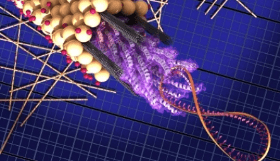Viruses harnessed to fabricate solar cells
on

According to researchers at MIT, living viruses can be harnessed to install highly conductive carbon nanotubes in the anode structures of dye sensitized solar cells, which increases their efficiency by nearly 30%. Dye sensitized solar cells are photo-electro-chemical systems with a semiconductor material located between a photo-sensitized anode and an electrolyte. Sunlight is absorbed by titanium dioxide nanoparticles covered with a dye, which release electrons into the anode. These electrons are collected to power a load, and then returned by the cathode to the electrolyte to close the loop. By harnessing a virus to lace the anode with nanotubes, the researchers managed to boost the cell efficiency from less than 8% to over 10.6%.
The MIT research team was led by professor Angela Belcher, who had previously demonstrated that a virus called M13 could fuel the hydrogen economy and pattern thin-film batteries. In their most recent project, the team used viruses to keep embedded nanotubes in solar cells separate so they don’t clump together or create short circuits. Each virus can hold about ten nanotubes in place, each containing approximately 300 peptide molecules, after which the genetically engineered viruses secrete a coating of titanium dioxide.
According to Belcher, MIT's new technique adds one simple step to the dye-sensitized solar cell manufacturing process, and it can also be adapted to other types of solar cells based on organic materials or quantum dots.
Image: Matt Klug, Biomolecular Materials Group, MIT


Discussion (0 comments)